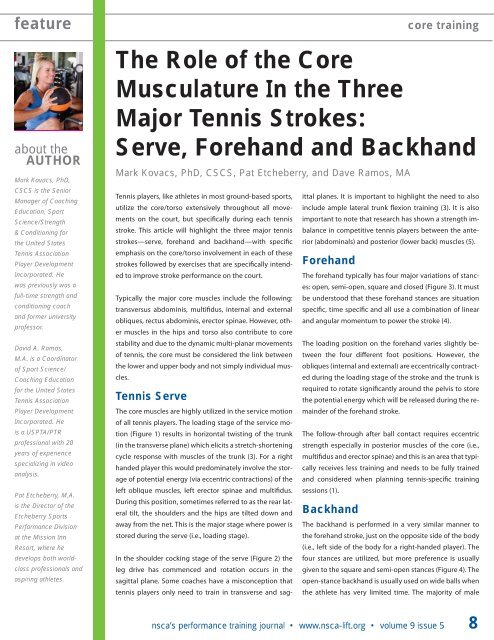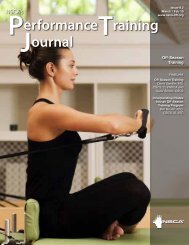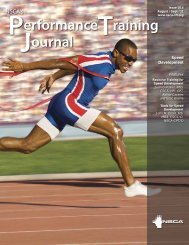PTJ Sep Oct 2010.pdf
PTJ Sep Oct 2010.pdf
PTJ Sep Oct 2010.pdf
You also want an ePaper? Increase the reach of your titles
YUMPU automatically turns print PDFs into web optimized ePapers that Google loves.
feature<br />
about the<br />
AUTHOR<br />
Mark Kovacs, PhD,<br />
CSCS is the Senior<br />
Manager of Coaching<br />
Education, Sport<br />
Science/Strength<br />
& Conditioning for<br />
the United States<br />
Tennis Association<br />
Player Development<br />
Incorporated. He<br />
was previously was a<br />
full-time strength and<br />
conditioning coach<br />
and former university<br />
professor.<br />
David A. Ramos,<br />
M.A. is a Coordinator<br />
of Sport Science/<br />
Coaching Education<br />
for the United States<br />
Tennis Association<br />
Player Development<br />
Incorporated. He<br />
is a USPTA/PTR<br />
professional with 20<br />
years of experience<br />
specializing in video<br />
analysis.<br />
Pat Etcheberry, M.A.<br />
is the Director of the<br />
Etcheberry Sports<br />
Performance Division<br />
at the Mission Inn<br />
Resort, where he<br />
develops both worldclass<br />
professionals and<br />
aspiring athletes.<br />
Mark Kovacs, PhD, CSCS, Pat Etcheberry, and Dave Ramos, MA<br />
core training<br />
The Role of the Core<br />
Musculature In the Three<br />
Major Tennis Strokes:<br />
Serve, Forehand and Backhand<br />
Tennis players, like athletes in most ground-based sports,<br />
utilize the core/torso extensively throughout all movements<br />
on the court, but specifically during each tennis<br />
stroke. This article will highlight the three major tennis<br />
strokes—serve, forehand and backhand—with specific<br />
emphasis on the core/torso involvement in each of these<br />
strokes followed by exercises that are specifically intended<br />
to improve stroke performance on the court.<br />
Typically the major core muscles include the following:<br />
transversus abdominis, multifidus, internal and external<br />
obliques, rectus abdominis, erector spinae. However, other<br />
muscles in the hips and torso also contribute to core<br />
stability and due to the dynamic multi-planar movements<br />
of tennis, the core must be considered the link between<br />
the lower and upper body and not simply individual muscles.<br />
Tennis Serve<br />
The core muscles are highly utilized in the service motion<br />
of all tennis players. The loading stage of the service motion<br />
(Figure 1) results in horizontal twisting of the trunk<br />
(in the transverse plane) which elicits a stretch-shortening<br />
cycle response with muscles of the trunk (3). For a right<br />
handed player this would predominately involve the storage<br />
of potential energy (via eccentric contractions) of the<br />
left oblique muscles, left erector spinae and multifidus.<br />
During this position, sometimes referred to as the rear lateral<br />
tilt, the shoulders and the hips are tilted down and<br />
away from the net. This is the major stage where power is<br />
stored during the serve (i.e., loading stage).<br />
In the shoulder cocking stage of the serve (Figure 2) the<br />
leg drive has commenced and rotation occurs in the<br />
sagittal plane. Some coaches have a misconception that<br />
tennis players only need to train in transverse and sagittal<br />
planes. It is important to highlight the need to also<br />
include ample lateral trunk flexion training (3). It is also<br />
important to note that research has shown a strength imbalance<br />
in competitive tennis players between the anterior<br />
(abdominals) and posterior (lower back) muscles (5).<br />
Forehand<br />
The forehand typically has four major variations of stances:<br />
open, semi-open, square and closed (Figure 3). It must<br />
be understood that these forehand stances are situation<br />
specific, time specific and all use a combination of linear<br />
and angular momentum to power the stroke (4).<br />
The loading position on the forehand varies slightly between<br />
the four different foot positions. However, the<br />
obliques (internal and external) are eccentrically contracted<br />
during the loading stage of the stroke and the trunk is<br />
required to rotate significantly around the pelvis to store<br />
the potential energy which will be released during the remainder<br />
of the forehand stroke.<br />
The follow-through after ball contact requires eccentric<br />
strength especially in posterior muscles of the core (i.e.,<br />
multifidus and erector spinae) and this is an area that typically<br />
receives less training and needs to be fully trained<br />
and considered when planning tennis-specific training<br />
sessions (1).<br />
Backhand<br />
The backhand is performed in a very similar manner to<br />
the forehand stroke, just on the opposite side of the body<br />
(i.e., left side of the body for a right-handed player). The<br />
four stances are utilized, but more preference is usually<br />
given to the square and semi-open stances (Figure 4). The<br />
open-stance backhand is usually used on wide balls when<br />
the athlete has very limited time. The majority of male<br />
nsca’s performance training journal • www.nsca-lift.org • volume 9 issue 5 8





